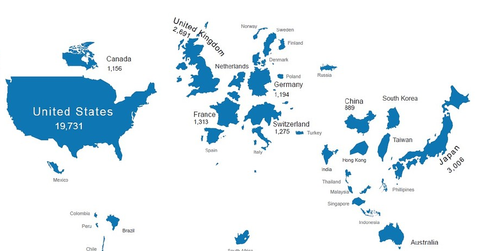International Diversification: Stepping outside the Comfort Zone
Some say investors should step step away from domestic markets to benefit from international diversification. The world has changed, and global financial markets are more interconnected.
Aug. 18 2016, Published 11:49 a.m. ET

Targeting countries and regions
Investors may be trepid when adding international investments to a portfolio because deciding where to start is not an easy feat. One of the ways closed-end funds can help in this area is the availability of country and region-specific funds. This enables investors to customize their portfolio to meet their goals.
Country-specific funds give investors the ability to customize their international portfolios based on convictions about individual countries. Regional closed-end funds make it possible to gain exposure in areas where a country-specific fund may not be available. Either way, closed end funds can be a flexible and practical way for investors to enter international markets and diversify their portfolio with global assets. In a recent Aberdeen Asset Management survey, 52% of those polled said they would recommend a closed-end fund in order to gain exposure to a certain asset class, sector or country.
Knowing where to go
Reaping the benefits of international diversification first requires investors to look beyond their comfort zone to opportunities outside of their domestic market. The next important step requires an understanding of what is happening abroad. The world has changed dramatically over the past few decades. The Morgan Stanley Capital International (or MSCI) indices provide an example of how investable global opportunities have greatly expanded over the last 40 years. In 1970, when MSCI was beginning to establish its global stock indices, its global universe comprised 16 countries in only the main developed markets.
Market Realist – Stepping away from domestic markets
Some say investors need to step step away from their domestic markets in order to benefit from international diversification. The world has changed, and global financial markets are more interconnected than ever before. Investors may want to allocate their assets accordingly.
The above graph from Bank of America Merrill Lynch provides food for thought by mapping world markets by their free-float equity market capitalizations.
The above graph shows the prevalence of equity home bias by country at the end of 2014. While the global index weight for the United States (VTI) (SPY) was only 51%, investor holdings in domestic equities was a whopping 79.1%.
This skew toward domestic equities was rampant in other developed nations (EFA) as well. The global index weights for Canada (EWC), the United Kingdom (EWU), Australia (IAF), and Japan (JEQ) were only 3.4%, 7.2%, 2.4%, and 7.2%, respectively. Investor holdings in domestic equities were 59%, 26.3%, 66.5%, and 55.2%, respectively.[1. source: Vanguard]
Only when investors recognize their penchant for equity home bias and step outside their comfort zones can they possibly reap the benefits of international diversification.
